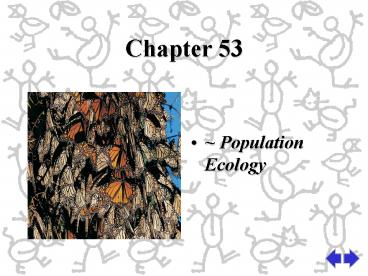~ Population Ecology PowerPoint PPT Presentation
Title: ~ Population Ecology
1
Chapter 53
- Population Ecology
2
Changes to population size
- Adding removing individuals from a population
- birth
- death
- immigration
- emigration
3
Population characteristics
- Density of individuals per unit of area
counts sample size estimate
indirect indicators
mark-recapture - Dispersion pattern of spacing random
unpredictable, patternless spacing (a)
clumped patchy aggregation (b)
uniform even spacing (c)
4
Demography factors that affect growth decline
of populations
- Birthrate (natality, fecundity) of offspring
produced - Death rate (mortality)
- Age structure relative number of individuals of
each age - Survivorship curve plot of numbers still alive
at each age
5
Population Growth Models
- Exponential model (red) idealized population in
an unlimited environment (J-curve) r-selected
species (rper capita growth rate) - Logistic model (blue) carrying capacity (K)
maximum population size that a particular
environment can support (S-curve) K-selected
species
6
Carrying capacity
- Can populations continue to grow exponentially?
- of course NOT!
- what sets limit?
- resources, predators, parasites
- Carrying Capacity (K)
- maximum population size that environment can
support with no degradation of habitat - not fixed varies with changes in resources
7
Model of growth
- Decrease in rate of growth as reach carrying
capacity
8
Population life history strategies
- r-selected (opportunistic)
- Short maturation lifespan
- Many (small) offspring usually 1 (early)
reproduction no parental care - High death rate
- K-selected (equilibrial)
- Long maturation lifespan
- Few (large) offspring usually several (late)
reproductions extensive parental care - Low death rate
9
Different life strategies
- K-selection
- r-selection
K-selection
mortality constant
r-selection
10
Population limiting factors
- Density-dependent factors competition
predation stress/crowding
waste accumulation - Density-independent factors weather/climate per
iodic disturbances
11
Age structure
- Relative number of individuals of each age
What do the data imply about population growth in
these countries?
12
Human population
2005?6 billion
- What factors have contributed to this exponential
growth pattern?
1650?500 million
PowerShow.com is a leading presentation sharing website. It has millions of presentations already uploaded and available with 1,000s more being uploaded by its users every day. Whatever your area of interest, here you’ll be able to find and view presentations you’ll love and possibly download. And, best of all, it is completely free and easy to use.
You might even have a presentation you’d like to share with others. If so, just upload it to PowerShow.com. We’ll convert it to an HTML5 slideshow that includes all the media types you’ve already added: audio, video, music, pictures, animations and transition effects. Then you can share it with your target audience as well as PowerShow.com’s millions of monthly visitors. And, again, it’s all free.
About the Developers
PowerShow.com is brought to you by CrystalGraphics, the award-winning developer and market-leading publisher of rich-media enhancement products for presentations. Our product offerings include millions of PowerPoint templates, diagrams, animated 3D characters and more.

